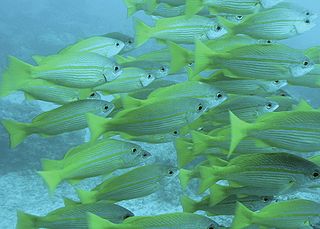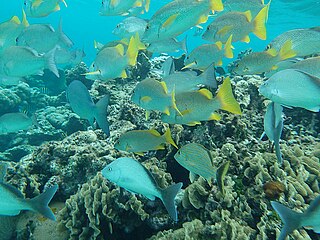
The Caesar grunt, also known as the black grunt, blacktail grunt, or redmouth grunt is a species of marine ray-finned fish, a grunt in the family Haemulidae. It is native to the western Atlantic Ocean.

The brownstriped grunt, also known as the burro, is a species of marine ray-finned fish, a grunt belonging to the family Haemulidae. It is native to the western Atlantic Ocean.

The bigeye snapper, also known as the bigeye seaperch, red sea lined snapper, golden striped snapper, rosy snapper, yellow snapper, or simply snapper, is a species of marine ray-finned fish, a snapper belonging to the family Lutjanidae. It is native to the Indian Ocean and the western Pacific Ocean. It is the type species of the genus Lutjanus.

Haemulon flavolineatum, the French grunt, banana grunt, gold laced grunt, open-mouthed grunt, redmouth grunt, or yellow grunt, is a species of marine ray-finned fish, a grunt belonging to the family Haemulidae. It is native to the western Atlantic Ocean.

The Borriqueta porgy is a species of marine ray-finned fish, a grunt belonging to the family Haemulidae. It is native to the Atlantic Coast of South America.
The dara is a species of marine ray-finned fish, a grunt belonging to the family Haemulidae. It is native to the Atlantic coast of Africa. It is the only species in the monospecific genus Parakuhlia.

Apsilus is a small genus of marine ray-finned fish, snappers belonging to the family Lutjanidae. The two species within the genus are native to the Atlantic Ocean,

Pristipomoides is a genus of marine ray-finned fish belonging to the family Lutjanidae, the snappers. They are found in the Atlantic, Indian and Pacific oceans.

Haemulon chrysargyreum, the smallmouth grunt, bronze grunt, or yellowstripe grunt, is a species of marine ray-finned fish, a grunt belonging to the family Haemulidae. It is found in the western Atlantic Ocean.
Plectorhinchus ceylonensis, the Sri Lanka sweetlips, is a species of marine ray-finned fish, a sweetlips belonging to the subfamily Plectorhinchinae, one of two subfamilies in the family Haemulidae, the grunts. It is native to the Indian Ocean around Sri Lanka. It inhabits waters over coral reefs at depths from 5 to 20 m. This species is rarely found in the aquarium trade.

Pomadasys maculatus, commonly known as the saddle grunt, blotched grunt or blotched javelin, is a species of marine ray-finned fish, a grunt belonging to the family Haemulidae. It is native to the Indo-West Pacific region.

Pomadasys kaakan, the javelin grunter or barred javelin is a species of marine ray-finned fish, a grunt belonging to the family Haemulidae. It is native to the Indian and Pacific Oceans, from Africa to Australia.

Haemulon album, the white margate, grey grunt, grunt, Margaret fish, Margaret grunt, margate, margate fish, ronco blanco, viuda, white grunt, white pogret, or yellow grunt is a species of ray-finned fish, a large grunt belonging to the family Haemulidae. It is native to the western Atlantic Ocean.

Caesio suevica, the Suez fusilier, is a species of marine ray-finned fish, a fusilier belonging to the family Caesionidae. It is endemic to the Red Sea.
Pomadasys macracanthus, the longspined grunt or Mexican gray perch, is a species of marine ray-finned fish, a grunt belonging to the family Haemulidae. It is native to the Eastern Pacific from Mexico to Ecuador.

Conodon nobilis, the barred grunt, is a species of marine ray-finned fish, a grunt belonging to the family Haemulidae. It is found in the Western Atlantic Ocean where it is a target species for some commercial fisheries.

Pomadasys argenteus, the silver grunt, silver javelin, grunter bream, small-spotted grunter-bream, small-spotted javelin fish, trumpeter or white-finned javelin fish, is a species of marine ray-finned fish, a grunt from the family Haemulidae. This species has a wide Indo-Pacific distribution. It is the type species of the genus Pomadasys.

The African striped grunt is a species of marine ray-finned fish, a sweetlips belonging to the subfamily Plectorhinchinae, one of two subfamilies in the family Haemulidae, the grunts. It is found in the eastern Atlantic Ocean.

The rubberlip grunt is a species of marine ray-finned fish, a sweetlips belonging to the subfamily Plectorhinchinae, one of two subfamilies in the family Haemulidae, the grunts. It is native to the eastern Atlantic Ocean.

The African forktail snapper, is a species of marine ray-finned fish, a snapper belonging to the family Lutjanidae. It is found in the eastern Atlantic Ocean.



















